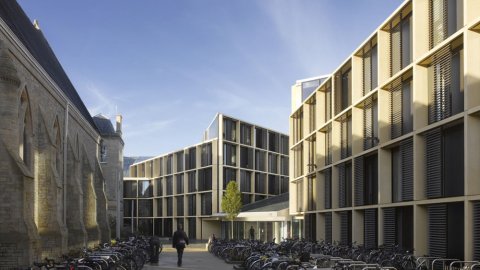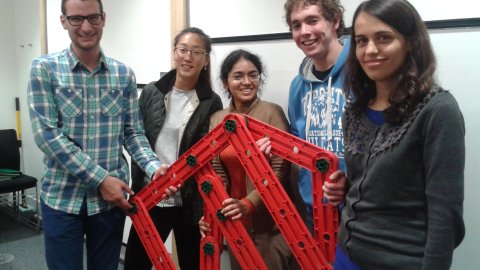14:15
The effect of lateral stresses on the flow of ice shelves and their role in stabilizing marine ice sheets
Abstract
It has been conjectured that marine ice sheets (those that
flow into the ocean) are unconditionally unstable when the underlying
bed-slope runs uphill in the direction of flow, as is typical in many
regions underneath the West Antarctic Ice Sheet. This conjecture is
supported by theoretical studies that assume a two-dimensional flow
idealization. However, if the floating section (the ice shelf) is
subject to three-dimensional stresses from the edges of the embayments
into which they flow, as is typical of many ice shelves in Antarctica,
then the ice shelf creates a buttress that supports the ice sheet.
This allows the ice sheet to remain stable under conditions that may
otherwise result in collapse of the ice sheet. This talk presents new
theoretical and experimental results relating to the effects of
three-dimensional stresses on the flow and structure of ice shelves,
and their potential to stabilize marine ice sheets.
14:15
Rogue waves in the open ocean — Non-linear walls of water
Abstract
There is wide interest in the oceanographic and engineering communities as to whether linear models are satisfactory for describing the largest and steepest waves in open ocean. This talk will give some background on the topic before describing some recent modelling. This concludes that non-linear physics produces only small increases in amplitude over that expected in a linear model — however, there are significant changes to the shape and structure of extreme wave-group caused by the non-linear physics.
14:15
Rapid Supraglacial Lake Drainages on the Greenland Ice Sheet: Observations, Inverse Modeling, and Mechanisms for Triggering Drainage
Abstract
Across much of the ablation region of the western Greenland Ice Sheet, hydro-fracture events related to supraglacial lake drainages rapidly deliver large volumes of meltwater to the bed of the ice sheet. We investigate what triggers the rapid drainage of a large supraglacial lake using a Network Inversion Filter (NIF) to invert a dense local network of GPS observations over three summers (2011-2013). The NIF is used to determine the spatiotemporal variability in ice sheet behavior (1) prior to lake drainage, and in response to (2) vertical hydro-fracture crack propagation and closure, (3) the opening of a horizontal cavity at the ice-sheet bed that accommodates the rapid injection of melt-water, and (4) extra basal slip due to enhanced lubrication. We find that the opening and propagation of each summer’s lake-draining hydro-fracture is preceded by a local stress perturbation associated with ice sheet uplift and enhanced slip above pre-drainage background velocities. We hypothesize that these precursors are associated with the introduction of meltwater to the bed through neighboring moulin systems.
14:15
Turbulence in shear flows with and without surface waves
Abstract
Surface waves modify the fluid dynamics of the upper ocean not only through wave breaking but also through phase-averaged effects involving the surface-wave Stokes drift velocity. Chief among these rectified effects is the generation of a convective flow known as Langmuir circulation (or “Langmuir turbulence”). Like stress-driven turbulence in the absence of surface waves, Langmuir turbulence is characterized by streamwise-oriented quasi-coherent roll vortices and streamwise streaks associated with spanwise variations in the streamwise flow. To elucidate the fundamental differences between wave-free (shear) and wave-catalyzed (Langmuir) turbulence, two separate asymptotic theories are developed in parallel. First, a large Reynolds number analysis of the Navier–Stokes equations that describes a self-sustaining process (SSP) operative in linearly stable wall-bounded shear flows is recounted. This theory is contrasted with that emerging from an asymptotic reduction in the strong wave-forcing limit of the Craik–Leibovich (CL) equations governing Langmuir turbulence. The comparative analysis reveals important structural and dynamical differences between the SSPs in shear flows with and without surface waves and lends further support to the view that Langmuir turbulence in the upper ocean is a distinct turbulence regime.
Computing harmonic measures for the Lévy stable process
Abstract
Abstract:In the first part of the talk, using classical hypergeometric identities, I will compute the harmonic measure of finite intervals and their complementaries for the Lévy stable process on the line. This gives a simple and unified proof of several results by Blumenthal-Getoor-Ray, Rogozin, and Kyprianou-Pardo-Watson. In the second part of the talk, I will consider the two-dimensional Markov process based on the stable Lévy process and its area process. I will give two explicit formulae for the harmonic measure of the split complex plane. These formulae allow to compute the persistence exponent of the stable area process, solving a problem raised by Zhan Shi. This is based on two joint works with Christophe Profeta.
The microstructural foundations of rough volatility models
Abstract
Abstract: It has been recently shown that rough volatility models reproduce very well the statistical properties of low frequency financial data. In such models, the volatility process is driven by a fractional Brownian motion with Hurst parameter of order 0.1. The goal of this talk is to explain how such fractional dynamics can be obtained from the behaviour of market participants at the microstructural scales.
Using limit theorems for Hawkes processes, we show that a rough volatility naturally arises in the presence of high frequency trading combined with metaorders splitting. This is joint work with Thibault Jaisson.




